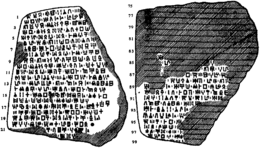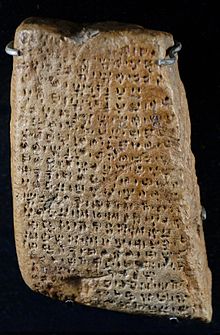- Cypro-Minoan syllabary
-
Cypro-Minoan 
Type Syllabary Languages unknown Time period ca. 1550-1050 BC Status Extinct Parent systems Linear A- Cypro-Minoan
Child systems Cypriot syllabary Note: This page may contain IPA phonetic symbols. The Cypro-Minoan syllabary (abbreviated CM) is an undeciphered syllabic script used on the island of Cyprus during the Late Bronze Age (ca. 1550-1050 BC). The term "Cypro-Minoan" was coined by Sir Arthur Evans in 1909 based on its visual similarity to Linear A on Minoan Crete, which CM is thought to be derived from. Approximately 250 objects bearing Cypro-Minoan inscriptions have been found, including clay tablets, votive stands, clay cylinders and clay balls. Discoveries have been made at various sites around Cyprus, as well as the ancient city of Ugarit on the Syrian coast.
The inscriptions have been classified into four closely related groups by Emilia Masson[1]: archaic CM, CM1 (also known as Linear C), CM2 and CM3, although some scholars disagree with this classification.[2] Little is known about how this script originated, or what language was used to write in CM. However, its use continued into the Early Iron Age, forming a link to the Cypriot syllabary, which reads as Greek and has been deciphered.
 Cypro-Minoan tablet from Enkomi in the Louvre.
Cypro-Minoan tablet from Enkomi in the Louvre.
Contents
Artifacts
Clay tablets
The earliest known inscription in CM was a clay tablet discovered in 1955 at the ancient site of Enkomi, near the east coast of Cyprus. It was dated to ca. 1500 BC, and bore three lines of writing.[3] Other fragments of clay tablets have been found at Enkomi and Ugarit.
Clay balls
Dozens of small clay balls, each bearing 3-5 signs in CM1, have been uncovered at Enkomi and Kition.
 Cypro-Minoan clay ball in the Louvre.
Cypro-Minoan clay ball in the Louvre.
Clay cylinders
Clay cylinder seals have been uncovered at Enkomi and Kalavassos-Ayios Dimitrios, some of which bear lengthy texts (more than 100 characters). It is likely that the balls and cylinder seals are related to the keeping of economic records on Minoan Cyprus, considering the large number of cross-references between the texts.[4]
Decipherment
The extant corpus of Cypro-Minoan is not large enough to allow for the isolated use of a cryptographic solution to decipherment. Currently, the total number of signs on formal Cypro-Minoan inscriptions (approx. 2500) compares unfavorably with the number known from the undeciphered Linear A documents (over 7000) and the number available in Linear B when it was deciphered (approx. 30,000). Furthermore, different languages may have been represented by the same Cypro-Minoan subsystem, and without the discovery of bilingual texts or many more texts in each subsystem, decipherment is extremely unlikely.[5] According to Thomas G. Palaima, "all past and current schemes of decipherment of Cypro-Minoan are improbable".[2]
Recent developments
- In 1998, Joanna S. Smith and Nicolle Hirshfeld received the 1998 Best of Show Poster Award at the annual meeting of the Archaeological Institute of America for their work on the Cypro-Minoan Corpus project, which aims to create a complete and accurate corpus of CM inscriptions, and archaeological and epigraphical discussions of all the evidence.[6]
See also
References
Sources
- Duhoux, Yves; Palaima, Thomas G.; Bennet, John; editors (1989). Problems in Decipherment. Louvain-La-Neuve: Peeters. ISBN 90-6831-177-8, pp. 121-188. Palaima (1988) Cypro-Minoan Scripts: Problems of Historical Context. Online preview.
- Woudhuizen, Fred (1992). The Language of the Sea Peoples. Amsterdam: Najade Press. ISBN 90-73835-02-X, pp. 81-153.
- Chadwick, James (1987). Linear B and Related Scripts. Berkeley: University of California Press. ISBN 0-520-06019-9, pp.50-56.
- Best, Jan; Woudhuizen, Fred (1988). Ancient Scripts from Crete and Cyprus. Leiden: E.J. Brill. ISBN 90-04-08431-2, pp. 98-131.
- . Faucounau Jean, "Les Inscriptions Chypro-Minoennes" , Paris 2007
- Masson, Emilia (1971). Studies in Cypro-Minoan Scripts. Part 1.. Göteborg: Astrom Editions. ISBN 978-91-85058-42-6.
- "CAARI News Number 18". Cyprus American Archaeological Research Institute. June 1999. pp. 5. http://www.fas.harvard.edu/~semitic/CAARI/CAARI18.pdf. Retrieved 2009-05-09.
Categories:- Syllabary writing systems
- Undeciphered writing systems
- Bronze Age writing systems
- Eteocretan language
- Aegean civilizations
- Bronze Age Cyprus
- Cypriot culture
Wikimedia Foundation. 2010.
